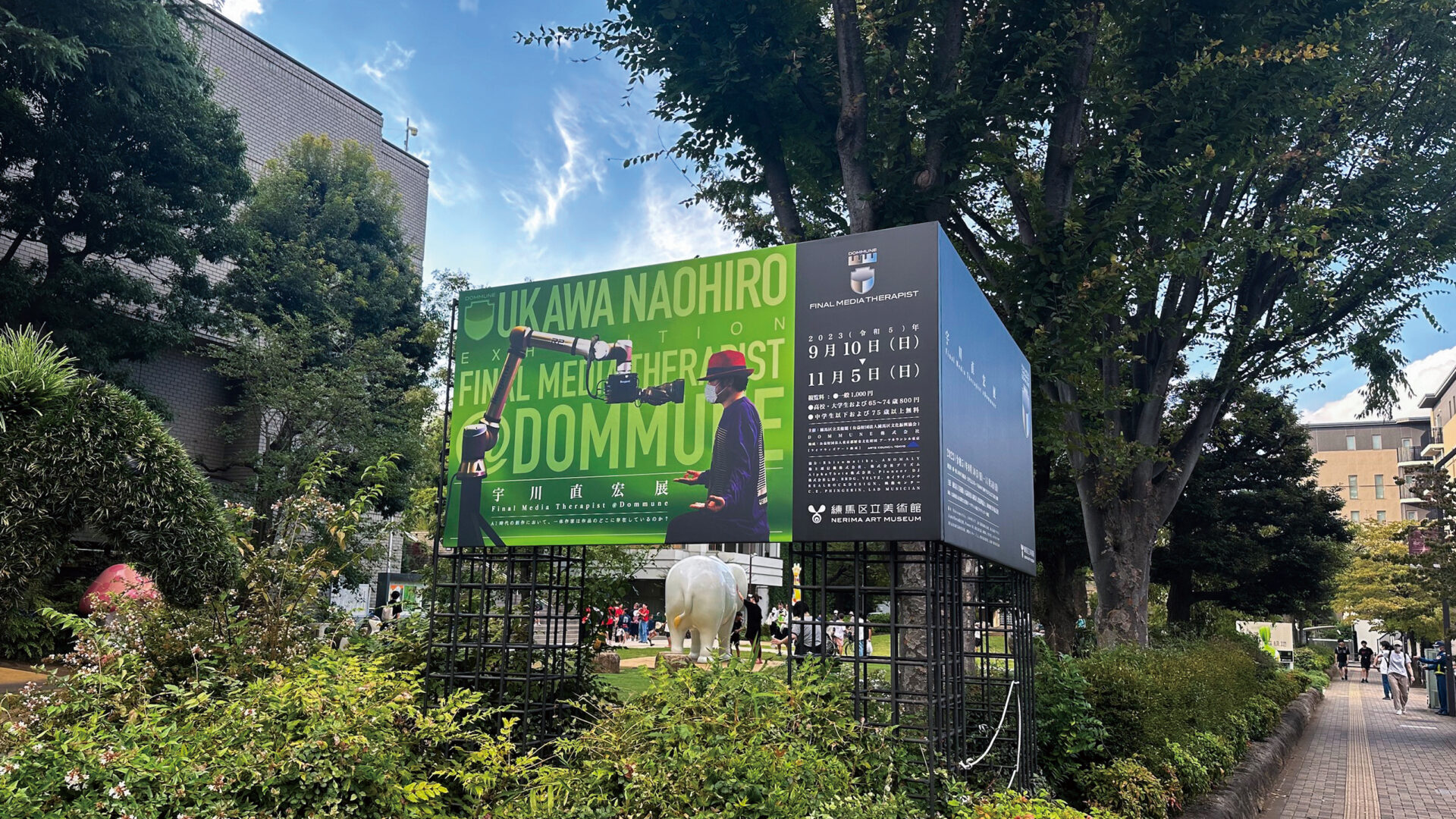Curator/critic. Artistic Director of “Forest for Dialogue and Creativity”. Visiting professor at Tama Art University and Tokyo Zokei University, lecturer at Musashino Art University and Institute of Advanced Media Arts and Sciences (IAMAS) and the Postgraduate School of Kokugakuin University. Her activities traverse existing fields by focusing on “Information flows”. In parallel, working as a curator of Canon ARTLAB (1990-2001), Mori Art Museum (2002-2004), senior curator of NTT InterCommunication Center[ICC] (2004-2010), as an independent curator, she realized many experimental exhibitions and projects and it is continued up to now..Juror of many domestic and international competitions, many co-publications. In 2023, the first book “Ecosophic Art” was published. yukikoshikata.com
UKAWA NAOHIRO “FINAL MEDIA THERAPIST @DOMMUNE,” Entrance of Nerima Art Museum, photo by Keizo Kioku
Dope and Contemplation: Feedback Spirals and the DOMMUNE Net
Since founding the livestreaming platform DOMMUNE in 2010, “current artist” Naohiro Ukawa has seen DOMMUNE and his daily life essentially blend into each other. Processing and transmitting a vast amount of information in rapid succession, Ukawa appears to exist in a doped-up condition, an extreme state of mind and body in which dopamine releases come frequently every day. Straddling fine art, the avant-garde, the underground, subcultures, and popular entertainment, he is one of those rare individuals who can speak deeply in his own words about a vast portion of Japanese culture going back to the postwar era of rapid economic growth. Simultaneously, Ukawa maintains a detached, contemplative perspective on a world that is constantly changing and being renewed.
This exhibition, based on DOMMUNE’s vast archive, focused especially on the issues of creation and authorship, including how Ukawa pertains to live streaming, in the post-pandemic, generative AI era. Visitors were invited to become a part of DOMMUNE’s unique live experience of on-the-spot documentary, data accumulation, and the generation of new visual material by AI in real time. Ukawa positioned the first half of the exhibition as the background leading up to this present-day experiment, presenting past DOMMUNE materials by hacking communication and video media equipment from the last century. The result could be interpreted as an amalgamation of DOMMUNE’s and media history.
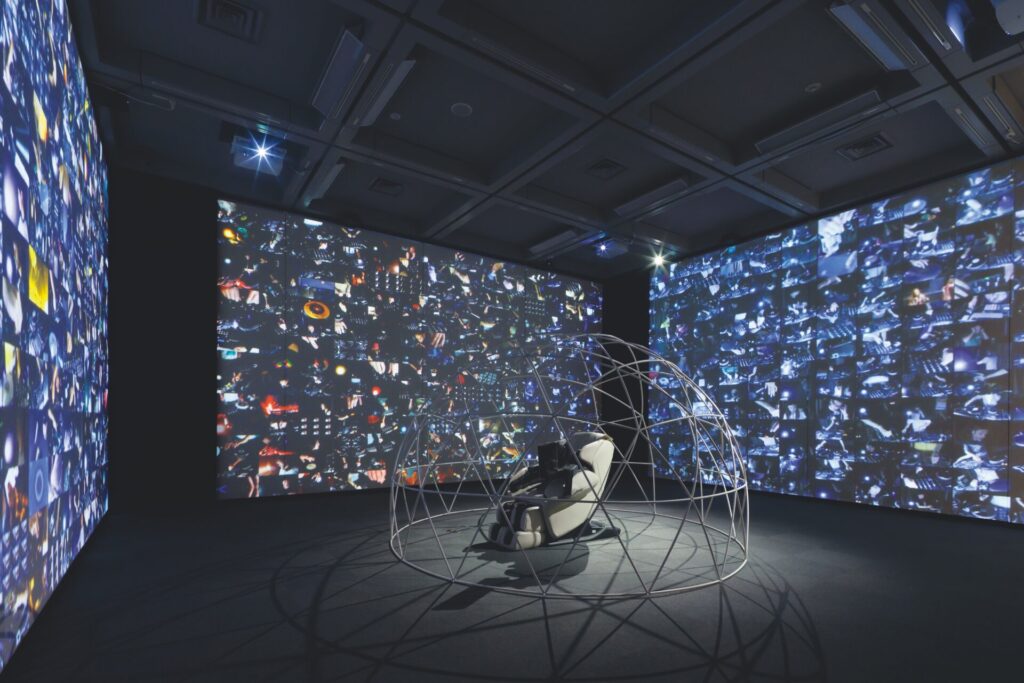
Chapter ∞: UKAWA NAOHIRO “NO BREATH Chapter 3 / NERIMA EDITION 2003-2023,” Chapter ∞: UKAWA NAOHIRO “DOMMUNE | DJ JOHN CAGE & THE 1000 WORLD WIDE DJS / with out JOHN CAGE” ⒸUKAWA NAOHIRO 2014 | 2023, courtesy of ANOMALY, photo by Keizo Kioku
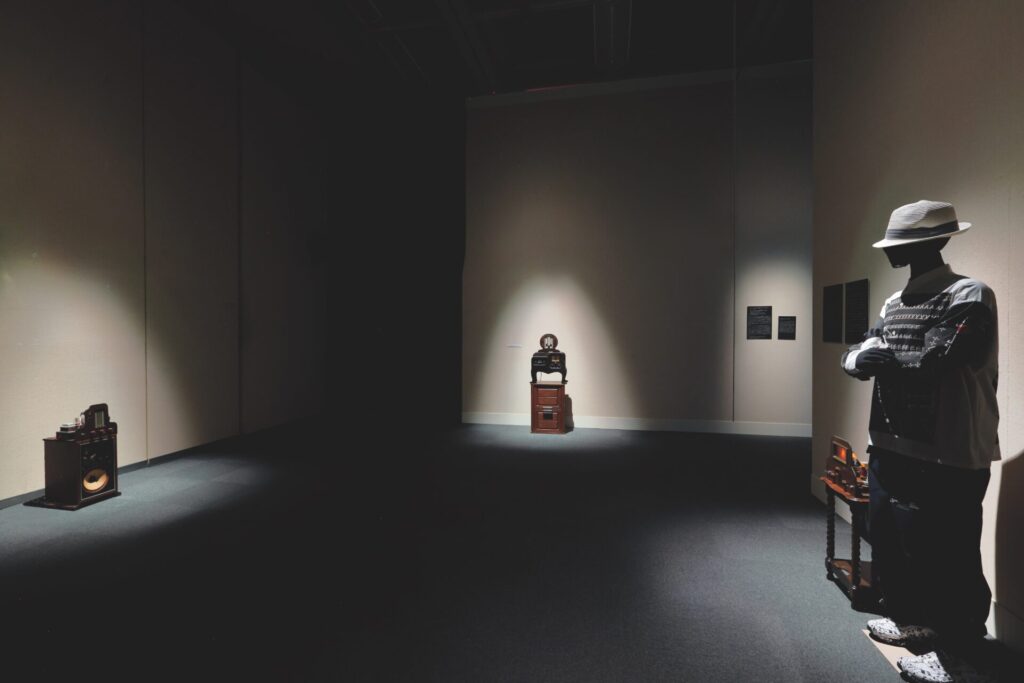
Chapter 1: UKAWA NAOHIRO “FILLER TUBE 3RADIOS” ⒸUKAWA NAOHIRO 2023, courtesy of ANOMALY, photo by Keizo Kioku
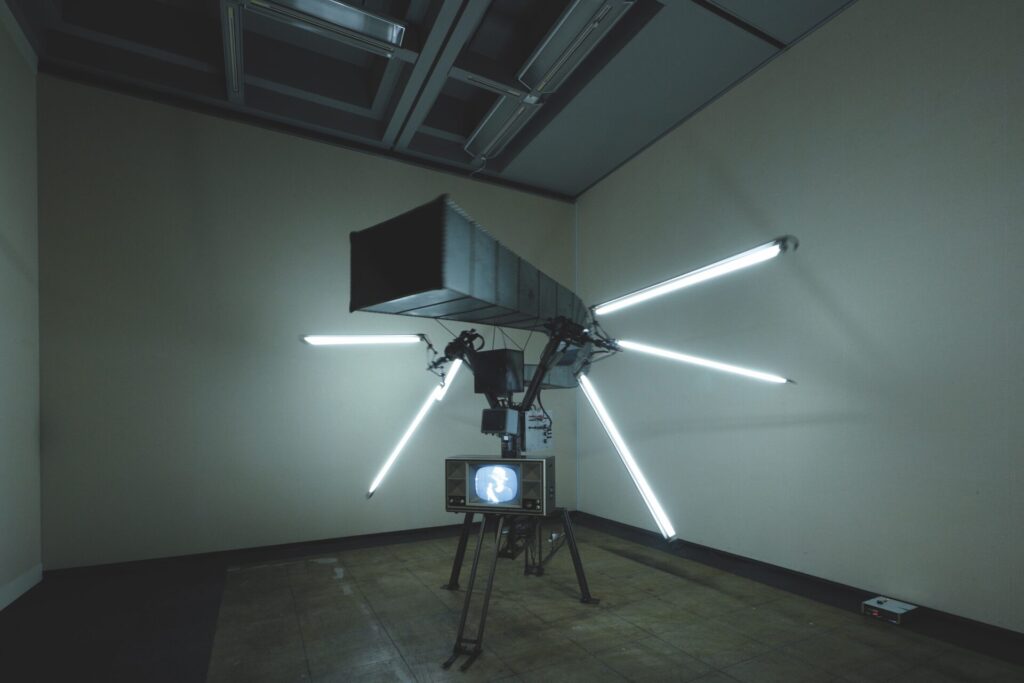
Chapter 2: UKAWA NAOHIRO collaborate with KAIRAI-BUNCH “Alejandro Jodorowsky’s ‘vacuum tube sermon'” ⒸUKAWA NAOHIRO KAIRAI-BUNCH 2023, courtesy of ANOMALY, supported by: Atsuhiro Ito (OPTORON), photo by Keizo Kioku
I’ll start with an overview of the exhibition, in which each room represented a distinct chapter. The introductory chapters 1 and ∞ (on the second floor) featured, respectively, an interview with Ukawa and two previously presented works (reworked for this exhibition), which were contrasted as to how they incorporated noise—specifically through the removal of filler sounds in speech (pause sounds such as “Uh…”) and the playing of white noise created by accumulating a vast amount of DJ sounds. Both chapters dealt with the distancing effect caused by a kind of violent (and playful) manipulation and transfer of information, and with the ambivalence (noise and order, pleasure and discomfort) experienced in this process.
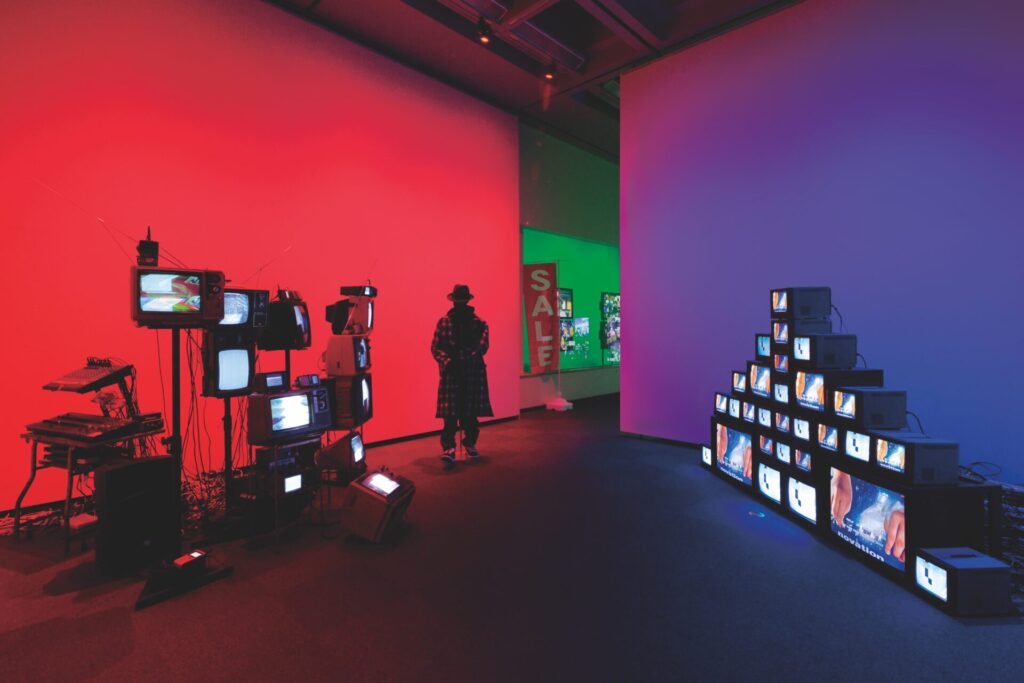
Chapter 3: UKAWA NAOHIRO collaborate with VELTZ “BRAUN TUBE HACKING” ⒸUKAWA NAOHIRO VELTZ 2023, courtesy of ANOMALY, Chapter 4: UKAWA NAOHIRO collaborate with REALROCKDESIGN “BRAUN TUBE VJING” ⒸUKAWA NAOHIRO REALROCKDESIGN 2023, courtesy of ANOMALY, supported by: Audio Visual Communications Ltd., photo by Keizo Kioku
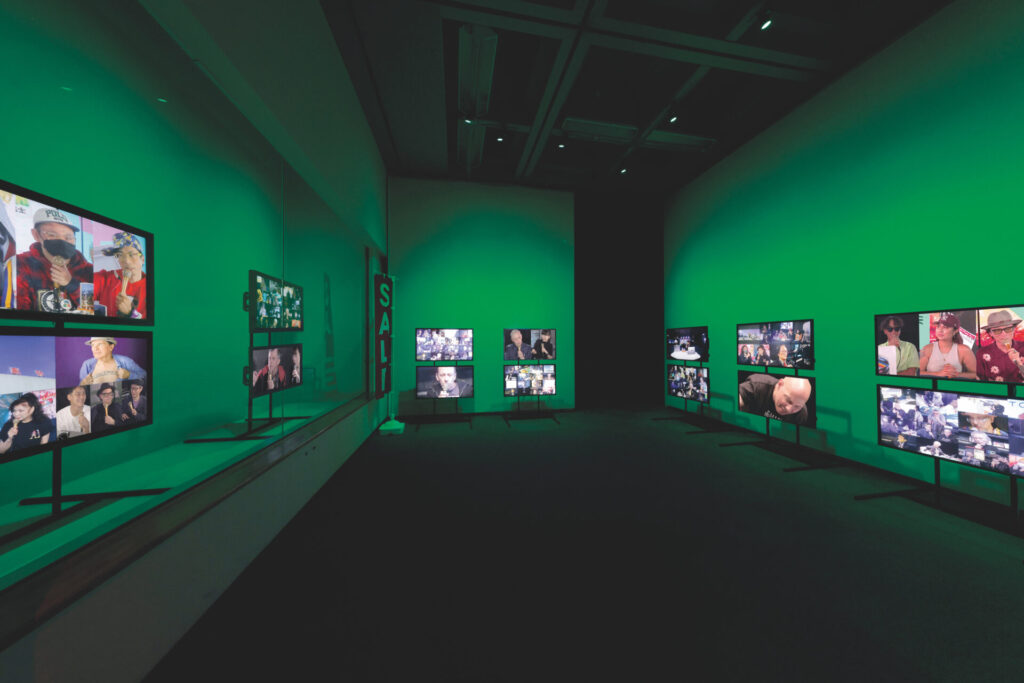
Chapter 5: UKAWA NAOHIRO & DOMMUNE|DOMMUNE ULTRA ARCHIVES Re-Edit by TAKAHASHI TAITO (DOMMUNE) “Consumer Electronics VS Alternative YouTuber” ⒸUKAWA NAOHIRO DOMMUNE 2023, courtesy of ANOMALY, photo by Keizo Kioku
Chapters 1 through 5 on the third floor (the main venue) chronicled the history of communication and visual media going back to the early twentieth century by way of the aforementioned DOMMUNE archive, played on equipment such as vacuum tube radios and TVs, CRT TVs, and LCD TVs. The use of noise and streaming archive hacking, the streaming and switching of VJ performances, and other interventions employed in the work all involve the joining of heterogeneous mediums and the exploration of, in Ukawa’s own words, “the possibilities of an analog chaosmos.” (Experiments with filler sounds were conducted here, too.)
Chapter 6 consisted of an unmanned satellite studio equipped with a streaming robot, in which an original generative AI kept creating what Ukawa calls “spatial paintings” by incorporating visitors in real time.
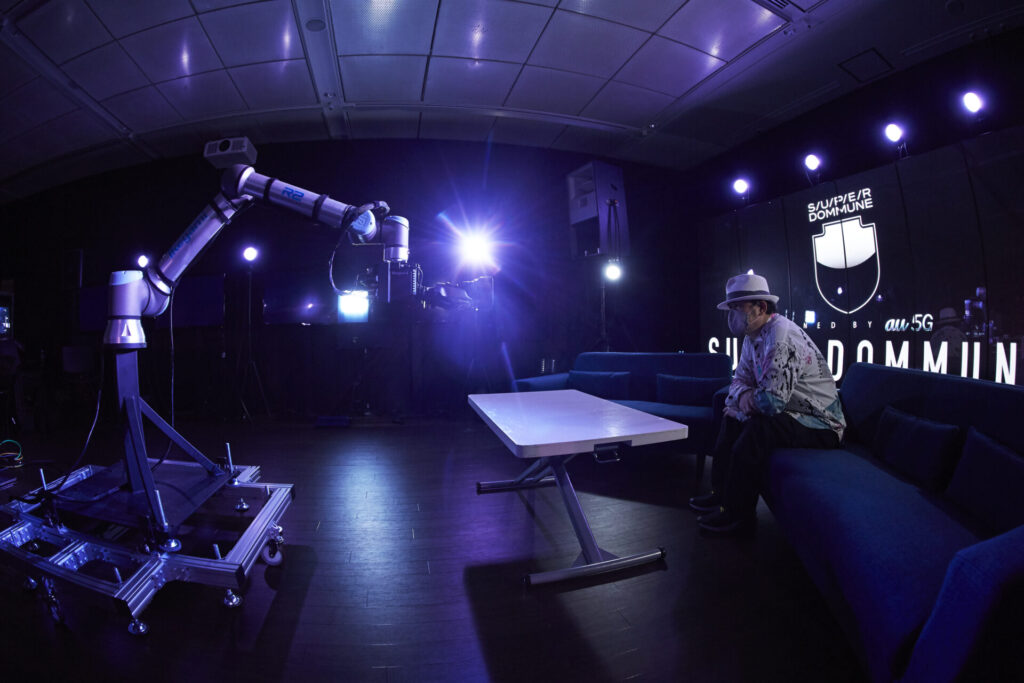
Chapter 6: UKAWA NAOHIRO with BRDG & IKEGAMI “Spatial Painting System composed of Generative AI and Robotic Arm” ⒸUKAWA NAOHIRO BRDG IKEGAMI 2023, courtesy of ANOMALY, photo by Toshio Ohno (L management) “WIRED” JAPAN VOL.38
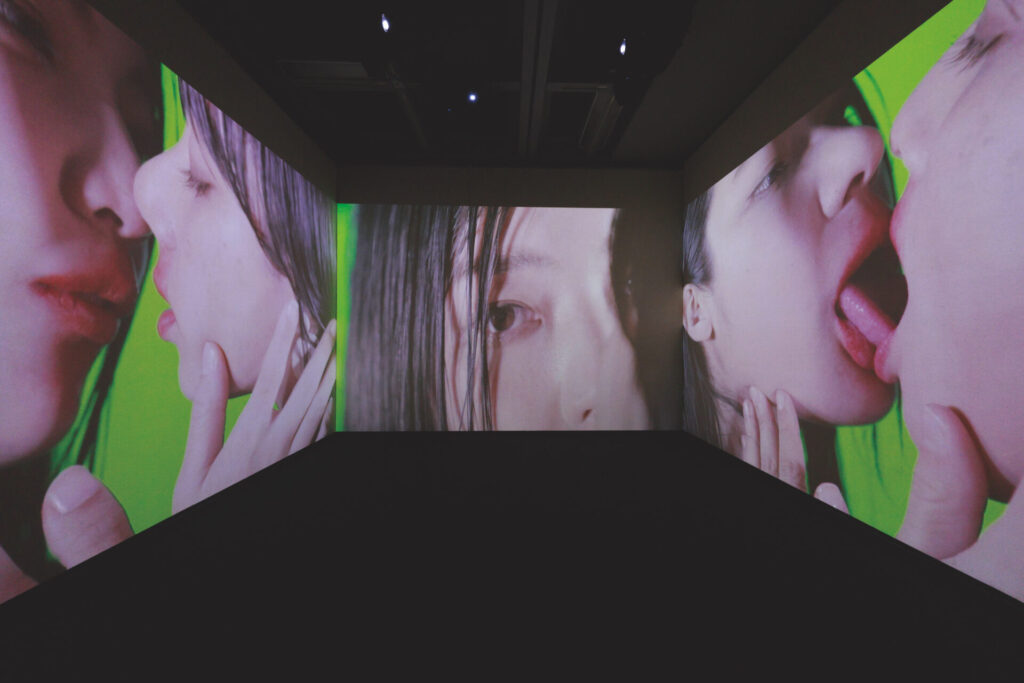
Chapter 7: UKAWA NAOHIRO “RIP EX TV|MASSIVE RESPECT TO RYUTARO KAMIOKA” ⒸUKAWA NAOHIRO 2023, courtesy of ANOMALY, photo by Keizo Kioku
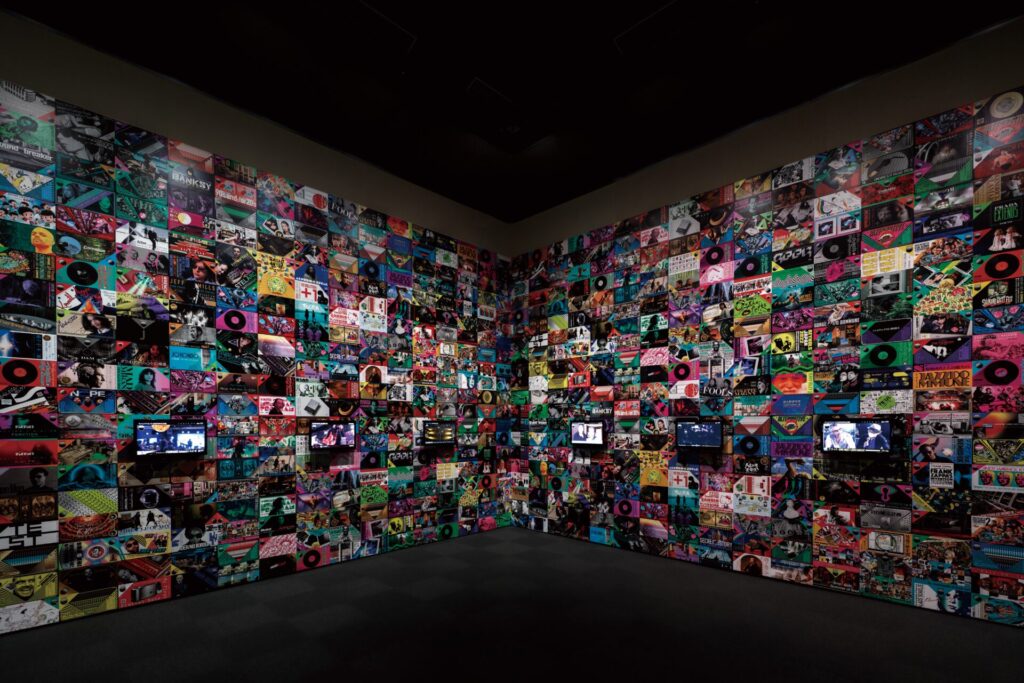
Chapter 8: UKAWA NAOHIRO “POST PANDEMIC THEATER” ⒸUKAWA NAOHIRO 2023, courtesy of ANOMALY, photo by Keizo Kioku
Chapters 7 through 9 highlighted the activities that DOMMUNE pursued through trial and error in the midst of the pandemic, as well as Ukawa’s thoughts and intentions behind them. Revealed here were the dynamics of the rise and fall of various media and the possibilities of inter-media collaboration, as well as various forms of intimacy and physical experiences among people (including a video of two Gen Z women sharing a passionate kiss—a tribute to Ryutaro Kamioka, who passed away in 2023, the DOMMUNE archive, and Terry Riley, who decided to remain in Japan after his participation in the Sado Island Galaxy Art Festival).
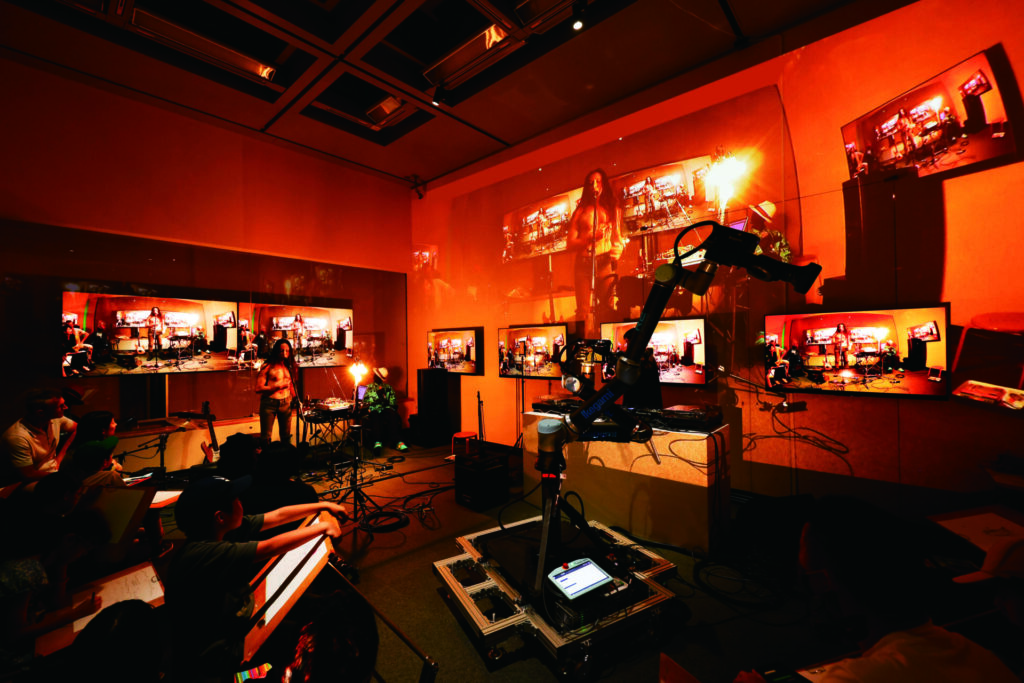
“DOMMUNE Drawing TV” Chapter 4—Let’s Draw DOMMUNE!, a special workshop at Nerima Art Museum, guest model: FUYUKI YAMAKAWA ⒸUKAWA NAOHIRO FUYUKI YAMAKAWA 2023, courtesy of ANOMALY, photo by Keizo Kioku
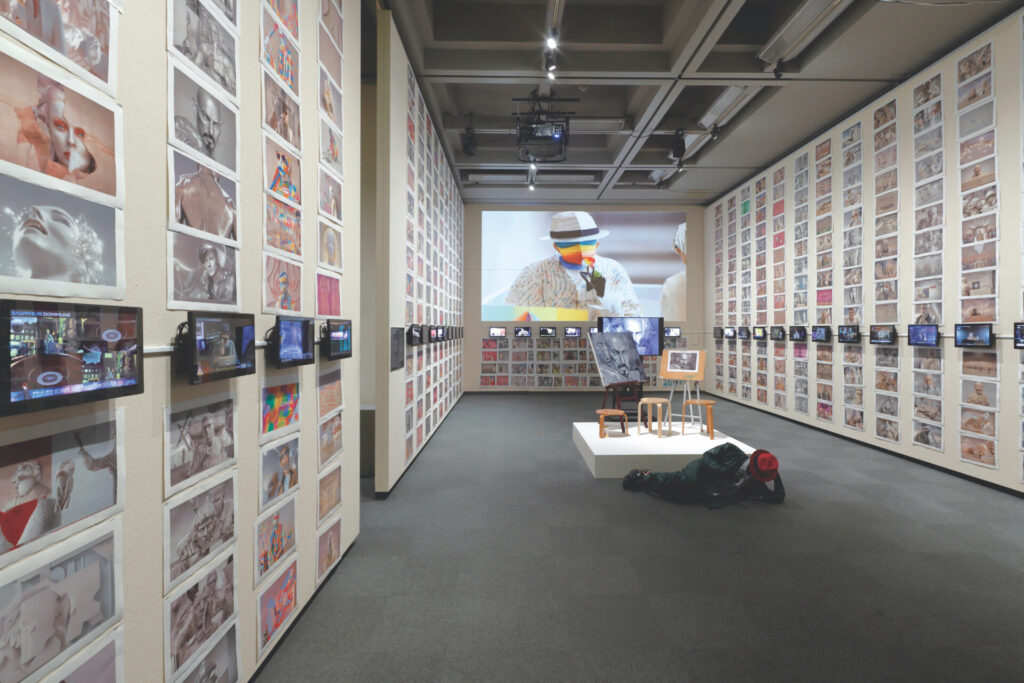
Chapter 11: UKAWA NAOHIRO “DOMMUNE Generated GENERATIVE AI 2023” ⒸUKAWA NAOHIRO 2023, courtesy of ANOMALY, photo by Keizo Kioku

Chapter 11: UKAWA NAOHIRO “DOMMUNE Generated GENERATIVE HUMAN 2023” ⒸUKAWA NAOHIRO 2023, courtesy of ANOMALY, photo by Keizo Kioku
This leaves the final two chapters, which unfolded live and featured generative AI, the exhibition’s quintessential element. (These were Chapter 10: “DOMMUNE drawn by humans and redrawn by real-time generative AI” and Chapter 11: “DOMMUNE drawn by generative AI and redrawn by flesh-and-blood humans.”) The former involved the development of an original AI flow for generating paintings, and continuous generation using that flow by training the AI on paintings created by the participants of four DOMMUNE live-streaming programs that included guests. In the latter, the AI—trained on about 300,000 words of Ukawa’s writing—generated images from the Dommune archives, which were then redrawn daily by a real person at the exhibition site. (These works were added to the exhibition throughout its duration.)
Ukawa holds that the emergence of generative AI, which ceaselessly and without human intervention creates moving images and paintings by drawing on vast databases and algorithms, will have a transformative impact on the nature of visual material and artists in our century. With this exhibition, he opened the door to a new frontier of experimentation. Perhaps this is an inevitable transition for Ukawa, who with DOMMUNE has pivoted from video production to live, collaborative creation and archival media. Deviation from authorship, creation by a system that transcends humanity—underlying Ukawa’s awe for and interest in the unknown is a hardcore independence and an alternative, critical spirit.
New imagery generated by AI and drawn by humans—this process could in principle continue endlessly while incorporating coincidences, malfunctions, and misperceptions. The results could be added to the DOMMUNE archive. And that’s not all; AI could eventually be used to generate and distribute content based on that archive, Ukawa’s MC voice could be generated in real time, and even “hybrid performers” could be generated by combining the data of multiple performers. Ukawa may be looking toward such a future, but he could also be plotting a deviation from it.
In our age, the recursive system of control defined as “feedback” by Norbert Wiener in his 1948 book “Cybernetics: Or Control and Communication in the Animal and the Machine” has been extended to the digital realm, becoming increasingly sophisticated by way of algorithms and dominating our daily lives. Against this backdrop, while Ukawa makes use of AI in this exhibition, he does not assign specific meaning or function to its products, instead opening them up to nonsensical and playful dissipation. He has chosen to intervene in the closed feedback loop, provoking contingencies, chains of them, and derivations from them.
In “Recursivity and Contingency” (2019), the philosopher Yuk Hui posits that “new perspectives on cybernetics can be seized by breaking down the discipline’s tendency to fall into a relative and deterministic way of thinking.” He advocates opening the technological universalism underlying the modern West to “technodiversity,” that is, “resituating various technologies within diverse cosmic realities.” (Like a shaman) Ukawa appears to intuitively perceive uncharted territory that calls for the heterogenization of technology and unexpected developments in data.
At the beginning of this review, I mentioned that Ukawa is both doped-up and contemplative—aspects that form an endless cycle (as in “∞,” one of the exhibition chapters). This is illustrated strikingly in the exhibition’s key visual, which shows Ukawa wearing a hat and face mask, facing a streaming robot equipped with a camera against a green screen (also a nod to Nam June Paik’s “TV Buddha”). Amid the contrast between man and machine and the vertical and horizontal, Ukawa casually joins the tips of his thumb and index finger in a chin mudra (the “gesture of consciousness” that in Buddhism is thought to connect the individual to the cosmos).
By forming circles on both sides, Ukawa’s body as a whole expresses infinite (∞)circulation. The lens of the camera that Ukawa is looking into would contain his reflection. In contrast, the robot would output the image of Ukawa’s face (and the lens reflected in his eyes, and Ukawa reflected there—an infinite nested state, though not visible) in real time, storing it in a database as a resource for a generative AI.
Behind the “eyes” of the robot lie the database of images taken during the exhibition and the algorithms that process both that data and the vast amounts of it collected over DOMMUNE’s 13-year history. By contrasting the immense volume of data and memories imprinted in Ukawa’s mind and body with the equally tremendous volume of data stored in computers and on hard drives, and by connecting the two (in a defamiliarizing way), this exhibition can be interpreted as an experiment to operate an open, infinite “feedback spiral” (rather than a loop) in which unexpected generation gives rise to new generation, without converging in a controlled state.
If we elaborate on Hui’s suggestion of Chinese “cosmotechnics” as an example of “technodiversity,” Ukawa can be seen to challenge the universality of postmodern technology while performing a deep reading of earlier Japanese technology and culture, thus weaving together the dope and the contemplative. Emanating from Ukawa, this dynamic can well be thought of as an instance of Japan-specific “technodiversity.”
I’d like to end by proposing that DOMMUNE itself is like a contemporary Indra’s net. The countless knots in the net said to hang over the palace of Indra, the Hindu king of heaven, are made of multifaceted jewels, each one being reflected in all of the others, thereby forming a perfectly interconnected universe. In DOMMUNE’s case, the model is not one of reflecting jewels, but rather one in which a ragtag array of intertwined (analog and digital) data form a dynamic network that only keeps growing. I’d like to call that data ecosystem “DOMMUNE’s net”…and imagine a gentle-faced Ukawa smiling through his mask somewhere in the shadows.
*As an aside, the exhibition title “Final Media Therapist” can also be read as “Final Media the Rapist.” Ukawa used to refer to himself as a “media rapist” (to express his hacker spirit and ethos of defamiliarization), and the degradation and healing of media are surely fundamentally linked to each other.)
*Note:; Quotes have been translated into English from the Japanese edition of “Recursively and Contingency” and may differ from the original text.
Translated by Ilmari Saarinen
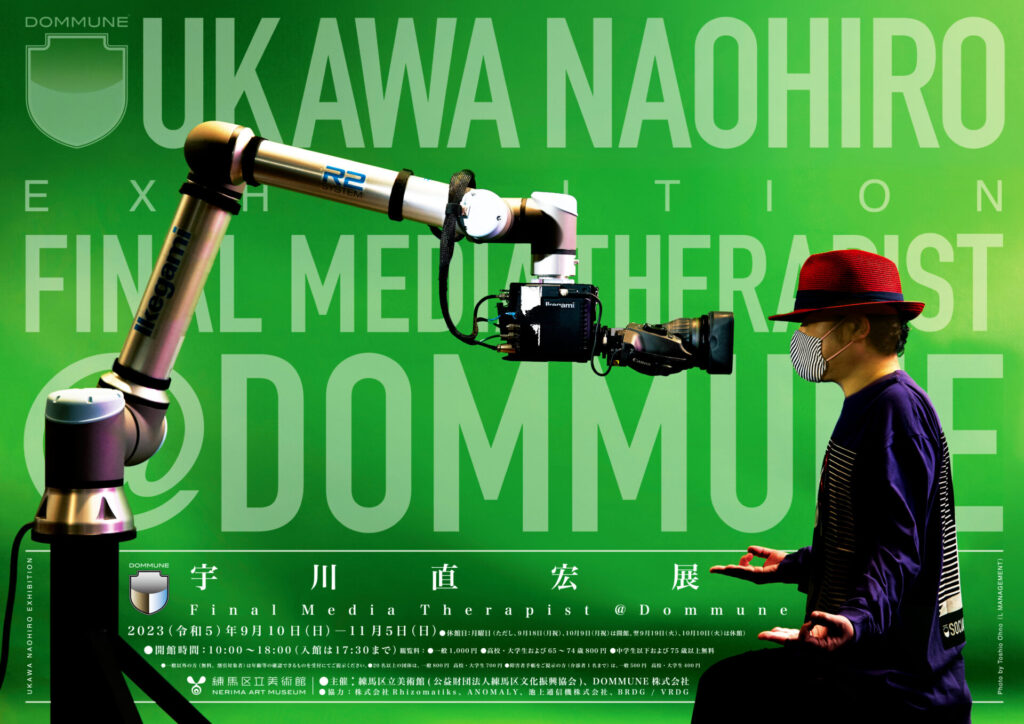
INFORMATION
NAOHIRO UKAWA “FINAL MEDIA THERAPIST@DOMMUNE"
Duration: 2023.9.10 - 11.5
Organized by: Nerima Art Museum, DOMMUNE
Under the Auspices of: Tokyo Metropolitan Foundation for History and Culture, Arts Council Tokyo "Life with Art Grant"
Supported by: Rhizomatiks, ANOMALY, IKEGAMI TSUSHINKI COMPANY LIMITED, PRISM CO., LTD.,
AlphaTheta Corporation, Pioneer DJ、NANASAI CO. LTD., BRDG, VELTZ、KAIRAI-BUNCH, REALROCKDESIGN, Audio Visual Communications Ltd., PHINGERIN, LAD MUSICIAN


